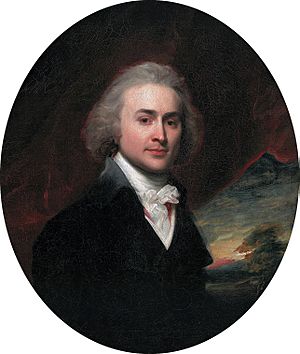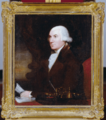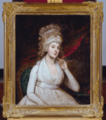Louisa Adams facts for kids
Quick facts for kids
Louisa Adams
|
|
|---|---|
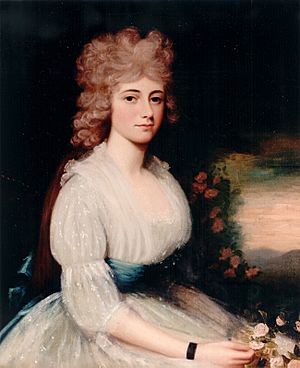
Portrait by Edward Savage, 1794
|
|
| First Lady of the United States | |
| In role March 4, 1825 – March 4, 1829 |
|
| President | John Quincy Adams |
| Preceded by | Elizabeth Monroe |
| Succeeded by | Emily Donelson (acting) |
| Personal details | |
| Born |
Louisa Catherine Johnson
February 12, 1775 City of London, England |
| Died | May 15, 1852 (aged 77) Washington, D.C., U.S. |
| Resting place | United First Parish Church |
| Spouse | |
| Children |
|
| Parents | Joshua Johnson (father) Catherine Newth (mother) |
| Signature | |
Louisa Catherine Adams (born Johnson; February 12, 1775 – May 15, 1852) was the First Lady of the United States from 1825 to 1829. She was married to John Quincy Adams, who served as the sixth President of the United States. Louisa Adams was the only First Lady born outside of the United States.
Contents
Early Life and Family
Louisa Catherine Johnson was born in the City of London, England, on February 12, 1775. Her father, Joshua Johnson, was an American merchant from Maryland. Her mother was Catherine Newth, an Englishwoman. Louisa was baptized on March 9, 1775.
She had six sisters and one brother. When Louisa was three years old, her family moved to Nantes, France. This was because her father supported the American Revolution. The family lived in France for five years. They became well-known among diplomats and ambassadors there.
Her Education
Louisa went to a Catholic boarding school when she was young. Later, her father's money problems meant she and her siblings had to leave. They were then taught by a governess at home. Louisa loved to read and was very good at art and music.
Marriage and Children
Louisa met John Quincy Adams at her father's home in London. Her father was working as the United States consul general there. John Quincy Adams first showed interest in Louisa's older sister. But he soon decided he liked Louisa more.
Louisa, who was 22, married John Quincy Adams, who was 30, on July 26, 1797. They were married in a church in London. John Quincy Adams's father, John Adams, was the President of the United States at the time. He welcomed Louisa into the family, even though they did not meet for several years.
Louisa's parents moved to the U.S. in 1797. Her father faced money problems and later died in 1802. Her mother died in 1811.
Louisa Adams had four children during her marriage:
- George Washington Adams (1801–1829), a lawyer.
- John Adams II (1803–1834), who worked for his father.
- Charles Francis Adams (1807–1886), a diplomat and writer.
- Louisa Catherine Adams (1811–1812), who was born and died in Russia.
Early Married Life
Louisa often did not feel well. She had frequent headaches and would sometimes faint. She also had several difficult pregnancies. Having grown up in London and France, she found Massachusetts very quiet. She once said the Adams family home felt "like something out of Noah's Ark." However, she grew to love her father-in-law, John Adams. She also respected her mother-in-law, Abigail Adams, whom she called "the guiding planet round which we all revolved."
Three years after they married, the couple moved to Berlin, Prussia. There, Louisa learned about diplomacy and what it meant to be a diplomat's wife.
In 1809, she left her two older sons in Massachusetts for school. She took her two-year-old son, Charles, to Russia. Her husband served as a Minister there. Life in Russia was hard, with cold winters, strange customs, and little money. An infant daughter born in 1811 died the next year.
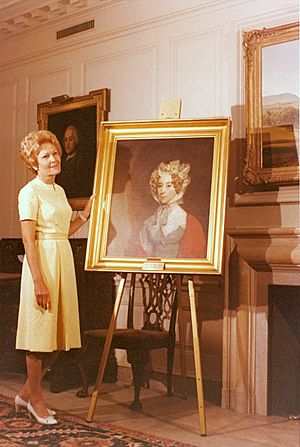
In 1814, John Quincy Adams went to Ghent for peace talks. He then went to London. Louisa traveled across Europe in winter to join him. She faced "unspeakable terrors" from groups of people on the roads. The next two years were a happy time for her family in her home country.
In 1817, John Quincy Adams became United States Secretary of State. The family moved to Washington, D.C. Louisa's home became a popular place for diplomats and important people to gather. Her Tuesday evening parties were known for music and theater. This made her a well-known hostess.
First Lady of the United States
Moving into the White House in 1825 was not as joyful as it might seem. The election had been very difficult, and Louisa felt very sad. She continued to host her weekly "drawing rooms" (social gatherings). But she preferred quiet evenings reading, writing music and poems, and playing her harp. As First Lady, she often felt withdrawn and sad. She sometimes wished she had never married into the Adams family. She felt the men in the family were cold and did not understand her feelings.
Even so, her parties were always elegant. Her warm welcome made the last official reception a pleasant event. This was true even though her husband had lost his bid for re-election, and political feelings were still very strong.
In his diary on June 23, 1828, her husband wrote that she was "winding silk from several hundred silkworms that she has been rearing." She was doing this right in the White House!
Historians have often ranked Louisa Adams among the upper half of First Ladies. They look at things like her background, courage, achievements, and how she helped the country and the president.
Life After the White House
After her husband lost the election, Louisa Adams thought they would retire to Massachusetts. However, in 1831, her husband began 17 years of service in the United States House of Representatives. The sad deaths of her two oldest sons added to her worries.
John Quincy Adams admitted that their marriage had its challenges. He noted they had "differences of sentiment, of tastes, and of opinions" about their home and raising children. But he also said she was always "a faithful and affectionate wife, and a careful, tender, indulgent, and watchful mother to our children."
Travels and Contributions
Louisa Adams traveled with John Quincy Adams to many countries. These included Russia, Poland, Germany, France, and England.
Some historians believe Louisa Catherine Adams played a big role in her husband's political career. She encouraged him to campaign. She also hosted many parties at their home and connected with important political people. This was before modern political campaigns existed.
Death and Legacy
Louisa's husband died on February 23, 1848, after a stroke. He was 80 years old. He had a state funeral in Washington, D.C. His body was then taken by train to be buried with his parents in United First Parish Church in Quincy, Massachusetts.
Louisa stayed in Washington until she died of a heart attack on May 15, 1852. She was 77 years old. The day of her funeral was special. It was the first time both houses of the United States Congress stopped work to mourn a woman. She is buried next to her husband, his parents, President John Adams and First Lady Abigail Adams, in Quincy, Massachusetts.
First Spouse Coin
The First Spouse Program allows the United States Mint to make special gold coins and medals. These coins honor the First Spouses of the United States. Louisa Adams's coin was released on May 29, 2008.
Museum Collections
Adams National Historical Park keeps Peacefield. This was the home where Louisa and her husband lived for some time. The park has a bedspread that Louisa made. It also has a painting of her by Edward Savage.
The Smithsonian's National Portrait Gallery has several pictures of Louisa Catherine Adams. These include a silhouette and a portrait on an ivory necklace.
Adams Memorial
There has been a suggestion to build an Adams Memorial in Washington, D.C. This memorial would honor John and Abigail Adams, John Quincy and Louisa Adams, and other members of their family.
Media Portrayals
Actress Caroline Corrie played Louisa Adams in the HBO miniseries John Adams.
Family Tree
|
||||||||||||||||||||||||||||||||||||||||||||||||||||||||||||||||||||||||||||||||||||||||||||||||||||||||||||||||||||||||||||||||||||||||||||||||||||||||||||||||||||||||||||||||||||||||||||||||||||||||||||||||||||||||||||||||||||||||||||||||||||||||||||||||||||||||||||||||||||||||||||||||||||||||||||||||||||||||||||||||||||||||||||||||||||||||||||||||||||||||||||||||||||||||||||||||||||||||||||||||||||||||||||||||||||||||||||||||||||||||||||||||||||||||||||||||||||||||||||||||||||||||||||||||||||||||||||||||||||||||||||||||||||||||||||||||||||||||||
| Notes: | ||||||||||||||||||||||||||||||||||||||||||||||||||||||||||||||||||||||||||||||||||||||||||||||||||||||||||||||||||||||||||||||||||||||||||||||||||||||||||||||||||||||||||||||||||||||||||||||||||||||||||||||||||||||||||||||||||||||||||||||||||||||||||||||||||||||||||||||||||||||||||||||||||||||||||||||||||||||||||||||||||||||||||||||||||||||||||||||||||||||||||||||||||||||||||||||||||||||||||||||||||||||||||||||||||||||||||||||||||||||||||||||||||||||||||||||||||||||||||||||||||||||||||||||||||||||||||||||||||||||||||||||||||||||||||||||||||||||||||
Writings
- The Diary and Autobiographical Writings of Louisa Catherine Adams: 1778–1850, two volumes.
- Margaret A. Hogan and C. James Taylor, editors, A Traveled First Lady: Writings of Louisa Catherine Adams (2014).
See also
 In Spanish: Louisa Adams para niños
In Spanish: Louisa Adams para niños
Images for kids


